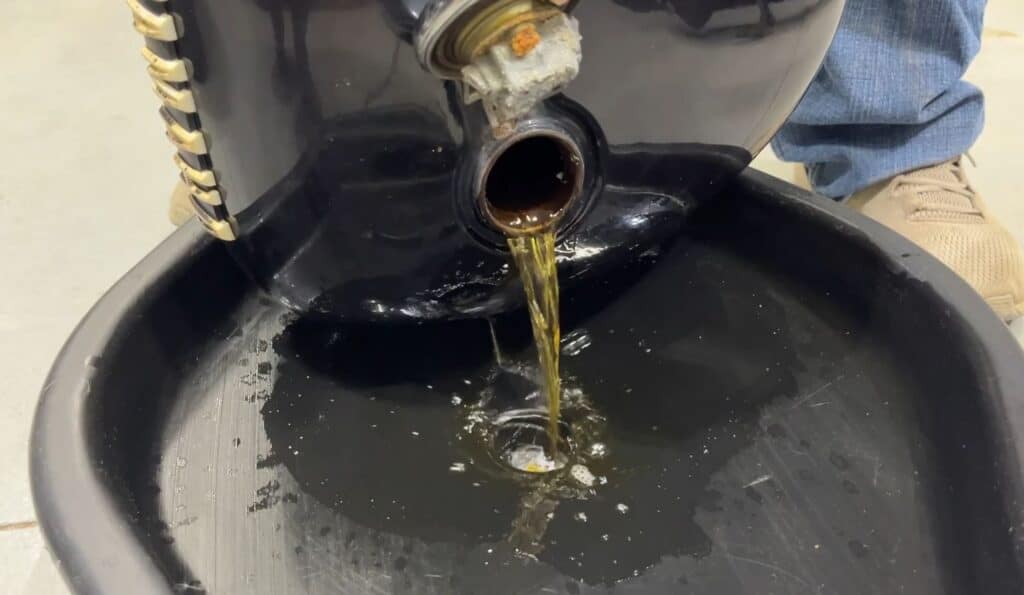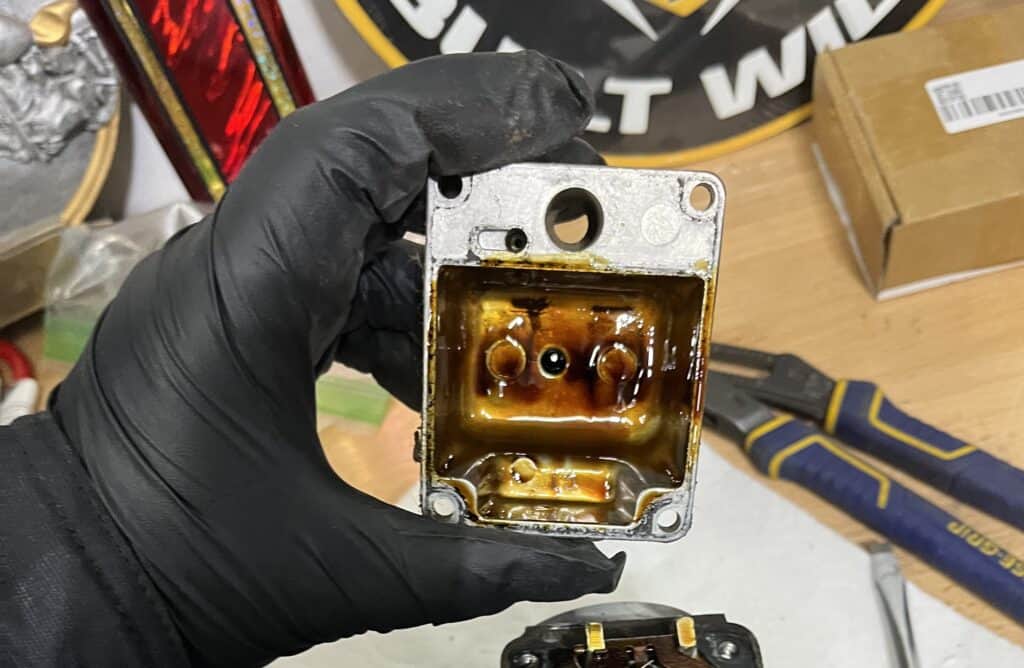
Most of us know what gas is and how it’s used. But there are less people who know about the properties of gas and it’s shelf life. It lasted thousands of years in the ground so it should be able to last just as long above ground, right?
The gasoline we see and use is much different than the gas that’s under ground because what we use is refined. Believe it or not, gas does have a shelf life. You may be planning to store your motorcycle for a while, or you just don’t ride it enough to use a full tank of gas all that often and wonder if that gas inside will eventually expire.
So, how long does it take for gas to go bad in a motorcycle? Unstabilized gas in a motorcycle can start going bad in about 30 days, especially when it is not being used. Stabilized gas can start going bad in about 6 months. The exposure to oxygen eventually changes the chemistry of gas which can lead to gum and varnish deposits. Gas should not be used if it has been sitting for longer than 6 months.
Since I work as an engineer with Chevron oil, I’m constantly discussing this subject at work and thoroughly know how this process works. Keep on reading and I can tell you all that I know and what you can do to prolong the gas life in your motorcycle.
Why Motorcycle Gas Goes Bad

When you imagine oil, you probably imagine a fountain of black liquid spewing out from the ground. This image has a lot to do with what movies portray about oil being discovered.
You may have noticed, however, the gas you put in your motorcycle is actually quite clear rather than looking like the black goo they find in the ground. That’s because the black stuff in the ground is still considered crude oil, or “unprocessed oil.”
Oil refineries process and refine this oil which gives us the gas we see and use everyday in our motorcycles. As soon as refineries define the gas to be up to par with their standards, they ship the gas to gas stations. The gas you put in your motorcycle from the gas station is not that old, usually only a few days since it was refined.
I’m going to get a little nerdy here. Working as an engineer professionally with Chevron oil as well as being an avid motorcycle rider and restorer, this is something I know a lot about.
Gas has a characteristic called volatility which means it vaporizes at an efficient rate that’s beneficial for your motorcycle engine. But because of it’s vaporizing characteristic, that means it will continue to do so whether or not the engine is using it. This means that over time the gas’s ability to combust will weaken.
The exposure to oxygen that gas has over time changes the chemistry of it altogether. So in addition to it vaporizing over time, the mix with oxygen creates gum and varnish deposits in the gas.
Motorcycle gas tanks as well as other parts of the fuel system also tend to collect condensation. This will lead to water mixture in the gas. This is especially relevant to motorcyclists who use ethanol gas; ethanol is essentially a water attractant and can increase the amount of moisture found in the fuel system.
The change in the chemistry of gasoline can happen quickly, especially if you are not using it or aren’t topping off your tank with fresh gas. The chemical changes can start at around 30 days after you fill your tank with gas and will continue to react over time.
Stabilized gas will also have this same chemical reaction but at a much slower rate since stabilizer prevents oxidation and moisture absorption. That’s why stabilized gas in a motorcycle won’t start going bad until about 6 months.
Performance Issues And How Bad Gas Affects Your Ride
Now that we’ve discussed the technical part of gasoline and it’s chemistry, you may be wondering how using bad gas can impact your motorcycle. Perhaps you’re planning on storing your motorcycle for the winter or for a long period time (see my guide here for long term storage), or maybe you only use your motorcycle occasionally that doesn’t require routine fill-ups.
Having restored dozens of motorcycles myself, I’ve seen first-hand what stagnant gas does to motorcycles.

Pictured above is a float bowl from my 1984 Yamaha Virago carburetor I’m restoring. The gas had been sitting in there for years. The gas inside this bowl literally felt like caramel.
As it was mentioned before, gas will eventually get gum and varnish deposits meaning it will gel up. Imagine all the small valves, jets, and lines that fuel gas has to go through to power your engine. Now imagine gel running through those same lines.
Basically, the number one things old gas will do to your motorcycle is clog up a lot of the parts in the fuel system. Gel gas also has a lot harder time combusting than liquid gas does, so the performance of your motorcycle will be poor.
Eventually if left untreated, your motorcycle will no longer be able to start or not run for very long. The clogged parts will prevent the fuel from circulating and it will basically leave your motorcycle unusable.
Reviving Your Motorcycle: Steps To Deal With Bad Gas
If you’ve become a victim of having old gas in your motorcycle and have noticed your motorcycle not running well or not running at all, please know that you haven’t completely ruined your machine.
Luckily there is a way to clear it all up and make your motorcycle good as new. You must be willing to spend a bit of time doing it though, because cleaning out your fuel system isn’t going to be just an hour long project. If you’re not sure if the gas in your motorcycle has gone bad, you can read our article “Watch Out For These 5 Symptoms Of Bad Gas In A Motorcycle.”
If you have a carburetor, you will need to completely take it off your motorcycle and rebuild it. This means you need to disassemble everything and give it a thorough clean, preferably with an ultrasonic cleaner. You’ll need to pay special attention to the jets and make sure they’re clear of debris.
You’ll probably need to replace all the fuel lines throughout your motorcycle. Those are inexpensive and shouldn’t take long to replace. Consider placing a fuel filter in your fuel line if you don’t already have one.
If you have a fuel injector, you’ll need to clean that as well. Cleaning those are a little different from cleaning a carburetor, but there are some great fuel injector cleaners out there that make the job easy.
Empty the gas tank as best as you can. You should be able to easily empty it by disconnecting the line from the petcock and turn the petcock all the way on. Be sure to have a container underneath to catch all the old gas running out. For a more thorough tutorial on how to drain bad gas from a motorcycle gas tank, see our YouTube video linked below:
Or you can read our article about it by clicking here.
Once you have assembled everything back together, you’re ready to add some fresh, new gas. You’ll probably still have some deposits throughout the system from the old gas circulating with the new gas, but hopefully your fuel filter can catch that. You may need to change your fuel filter a littler sooner than normal after you do this.
Fueling Longevity: Shielding Your Motorcycle Against Bad Gas Woes
Whether you’ve had to go through the endeavor of cleaning out old gas from your motorcycle, or you simply want to prevent such horror, there are a few preventative steps you can take to keep your motorcycle fuel system in check.
If you plan on having your motorcycle sit for a while, you should always add a stabilizer to the gas. Fuel stabilizer is a solution that can provide protection to the gas sitting in your motorcycle. It bonds with the gas it is mixed with and helps prevent the gas from vaporizing so quickly. Essentially it slows down the chemical reaction gas has with oxygen.
Once you add fuel stabilizer, make sure you turn on and run your motorcycle for a few minutes so the stabilizer has time to circulate through the fuel system and remain in all parts of the system. You should not use stabilized gas older than 6-12 months because the inevitable chemical reactions gas has will eventually still take place by then.
If you are storing your motorcycle for a longer period of time such as several years, it is best that you completely empty the gas tank and fuel system altogether. Though this does run the risk of condensation build up inside the gas tank, your risk is higher with keeping old gas in there and letting it sit.
Conclusion
The gas inside your motorcycle gas tank has a life expectancy and any use after that expectancy will likely start some issues within your motorcycle. Remember, gas can start going bad around 30 days while stabilized gas starts going bad around 6 months.
My hope is that through my experience as an engineer working in the oil industry and being a motorcycle enthusiast, I’ve been able to teach you about gas properties and how to best care for your motorcycle. Feel free to contact us if you have questions!
Related Questions
Can gas go bad in other recreation vehicles? The properties and chemistry of gas acts the same no matter what type of vehicle it is in. Vehicles that have old gas in them, such as four wheelers, snowmobiles, and cars, will run into the same issues as motorcycles do including a clogged fuel system.
Does engine oil ever go bad? Like gasoline, oil can also go bad. Once oil is opened from a sealed container and placed inside an engine, it can start going bad after a few months and shouldn’t be used longer than 6 months. The shelf life in a sealed container is much longer where it can last several years.
